Project Risk and Procurement Analysis for HSBC Bank: A Detailed Study
VerifiedAdded on 2023/06/06
|13
|3967
|223
Project
AI Summary
This project delves into the realm of project risk and procurement, focusing on HSBC Bank as a case study. The analysis begins with an introduction to project risk and its significance, emphasizing the need for thorough risk assessment in the banking sector. It then outlines the scope of the study, highlighting the importance of identifying both internal and external risks. A comprehensive literature review is presented, covering the concept of project risk, various risk theories, and different models used for risk management. The study further explores critical analysis of risks and effective risk management strategies, including risk minimization techniques. The project examines the various types of risks faced by HSBC, such as economic downturns, competition, and internal issues like employee dishonesty and cyber threats. The study then analyzes the qualitative and quantitative methods of risk assessment, discussing the importance of risk evaluation, prioritization, and response planning. The project concludes by emphasizing the need for tailored risk management plans and the use of risk registers to effectively manage project risks within the bank. The assignment provides a detailed overview of the challenges and opportunities in the banking sector, offering valuable insights into project risk management.

PROJECT RISK AND PROCUREMENT
Paraphrase This Document
Need a fresh take? Get an instant paraphrase of this document with our AI Paraphraser
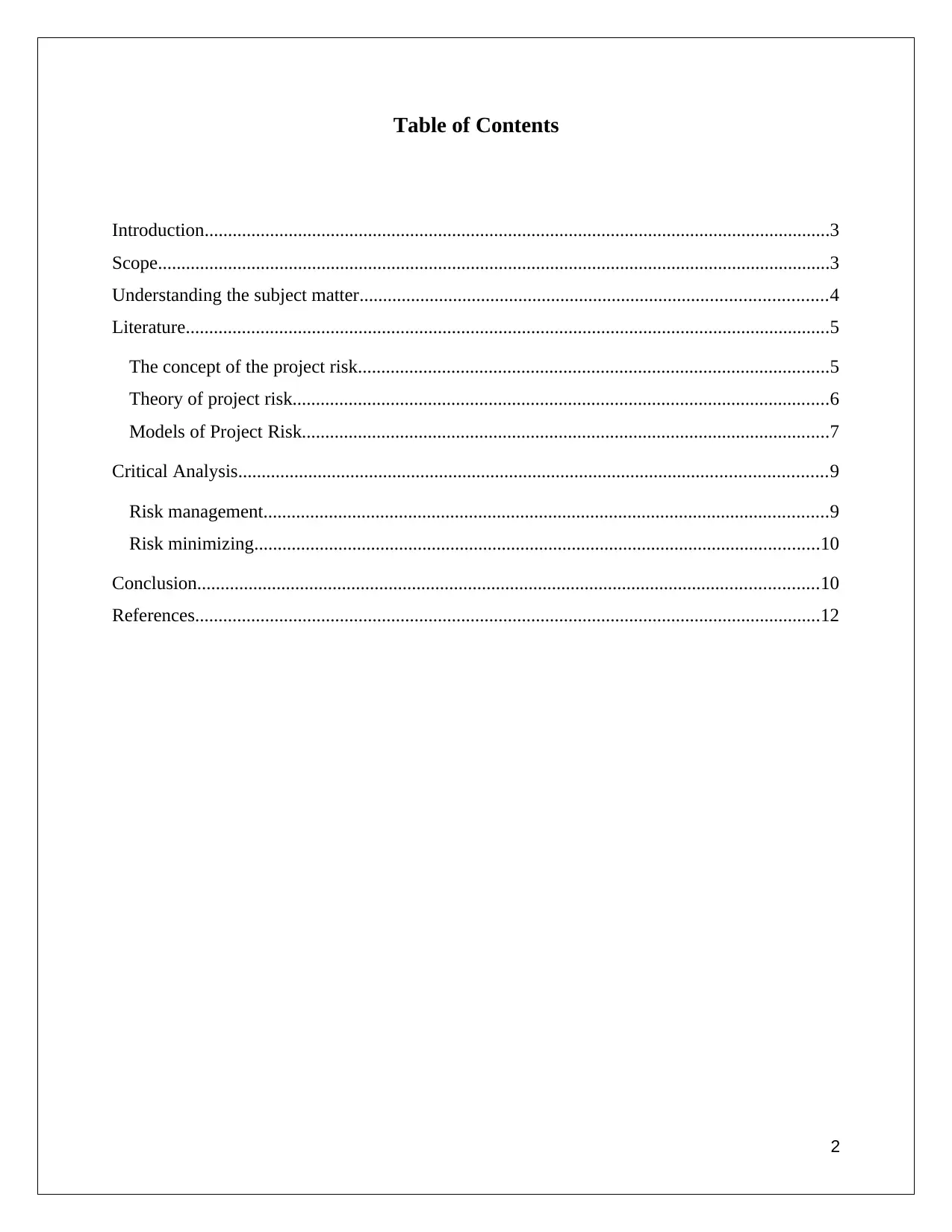
Table of Contents
Introduction......................................................................................................................................3
Scope................................................................................................................................................3
Understanding the subject matter....................................................................................................4
Literature..........................................................................................................................................5
The concept of the project risk.....................................................................................................5
Theory of project risk...................................................................................................................6
Models of Project Risk.................................................................................................................7
Critical Analysis..............................................................................................................................9
Risk management.........................................................................................................................9
Risk minimizing.........................................................................................................................10
Conclusion.....................................................................................................................................10
References......................................................................................................................................12
2
Introduction......................................................................................................................................3
Scope................................................................................................................................................3
Understanding the subject matter....................................................................................................4
Literature..........................................................................................................................................5
The concept of the project risk.....................................................................................................5
Theory of project risk...................................................................................................................6
Models of Project Risk.................................................................................................................7
Critical Analysis..............................................................................................................................9
Risk management.........................................................................................................................9
Risk minimizing.........................................................................................................................10
Conclusion.....................................................................................................................................10
References......................................................................................................................................12
2
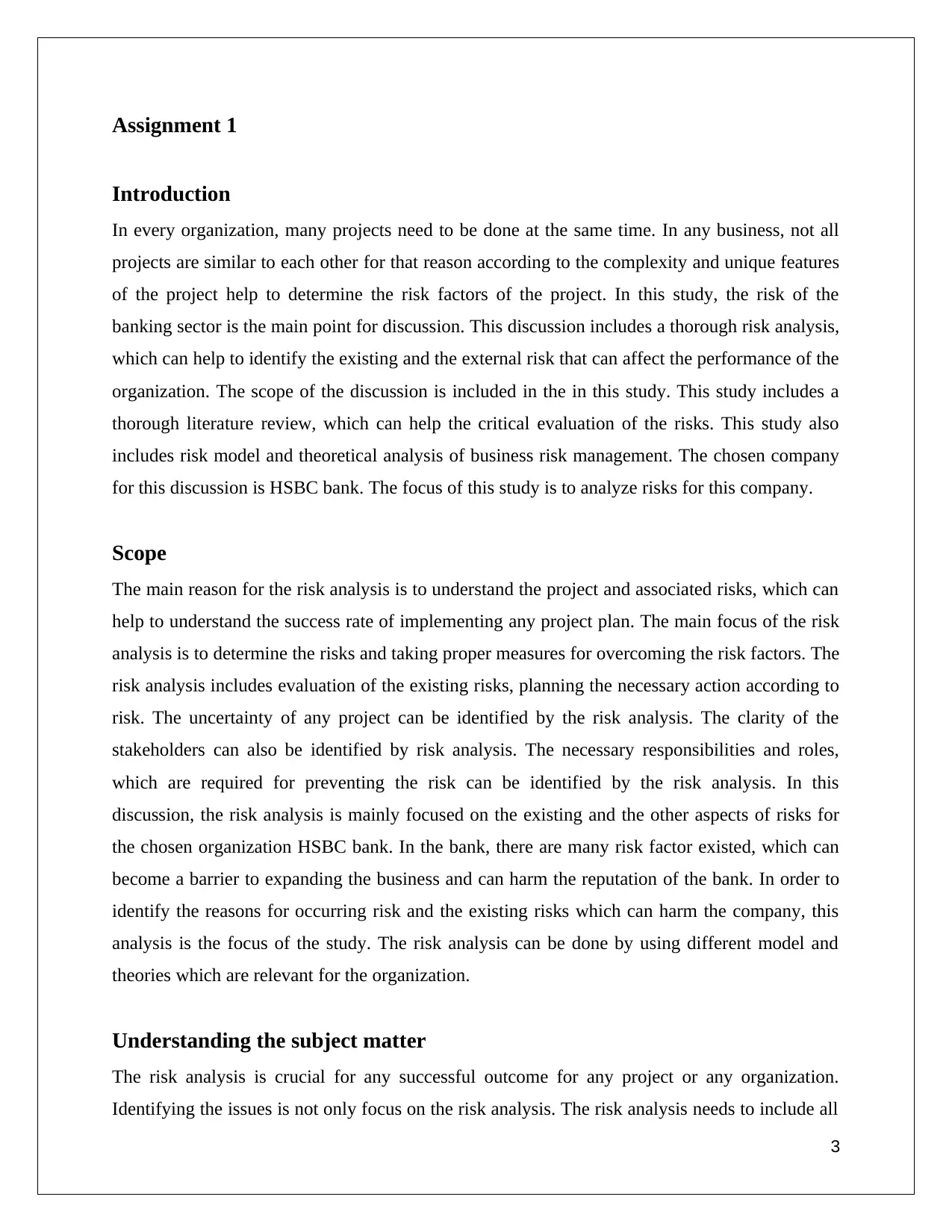
Assignment 1
Introduction
In every organization, many projects need to be done at the same time. In any business, not all
projects are similar to each other for that reason according to the complexity and unique features
of the project help to determine the risk factors of the project. In this study, the risk of the
banking sector is the main point for discussion. This discussion includes a thorough risk analysis,
which can help to identify the existing and the external risk that can affect the performance of the
organization. The scope of the discussion is included in the in this study. This study includes a
thorough literature review, which can help the critical evaluation of the risks. This study also
includes risk model and theoretical analysis of business risk management. The chosen company
for this discussion is HSBC bank. The focus of this study is to analyze risks for this company.
Scope
The main reason for the risk analysis is to understand the project and associated risks, which can
help to understand the success rate of implementing any project plan. The main focus of the risk
analysis is to determine the risks and taking proper measures for overcoming the risk factors. The
risk analysis includes evaluation of the existing risks, planning the necessary action according to
risk. The uncertainty of any project can be identified by the risk analysis. The clarity of the
stakeholders can also be identified by risk analysis. The necessary responsibilities and roles,
which are required for preventing the risk can be identified by the risk analysis. In this
discussion, the risk analysis is mainly focused on the existing and the other aspects of risks for
the chosen organization HSBC bank. In the bank, there are many risk factor existed, which can
become a barrier to expanding the business and can harm the reputation of the bank. In order to
identify the reasons for occurring risk and the existing risks which can harm the company, this
analysis is the focus of the study. The risk analysis can be done by using different model and
theories which are relevant for the organization.
Understanding the subject matter
The risk analysis is crucial for any successful outcome for any project or any organization.
Identifying the issues is not only focus on the risk analysis. The risk analysis needs to include all
3
Introduction
In every organization, many projects need to be done at the same time. In any business, not all
projects are similar to each other for that reason according to the complexity and unique features
of the project help to determine the risk factors of the project. In this study, the risk of the
banking sector is the main point for discussion. This discussion includes a thorough risk analysis,
which can help to identify the existing and the external risk that can affect the performance of the
organization. The scope of the discussion is included in the in this study. This study includes a
thorough literature review, which can help the critical evaluation of the risks. This study also
includes risk model and theoretical analysis of business risk management. The chosen company
for this discussion is HSBC bank. The focus of this study is to analyze risks for this company.
Scope
The main reason for the risk analysis is to understand the project and associated risks, which can
help to understand the success rate of implementing any project plan. The main focus of the risk
analysis is to determine the risks and taking proper measures for overcoming the risk factors. The
risk analysis includes evaluation of the existing risks, planning the necessary action according to
risk. The uncertainty of any project can be identified by the risk analysis. The clarity of the
stakeholders can also be identified by risk analysis. The necessary responsibilities and roles,
which are required for preventing the risk can be identified by the risk analysis. In this
discussion, the risk analysis is mainly focused on the existing and the other aspects of risks for
the chosen organization HSBC bank. In the bank, there are many risk factor existed, which can
become a barrier to expanding the business and can harm the reputation of the bank. In order to
identify the reasons for occurring risk and the existing risks which can harm the company, this
analysis is the focus of the study. The risk analysis can be done by using different model and
theories which are relevant for the organization.
Understanding the subject matter
The risk analysis is crucial for any successful outcome for any project or any organization.
Identifying the issues is not only focus on the risk analysis. The risk analysis needs to include all
3
⊘ This is a preview!⊘
Do you want full access?
Subscribe today to unlock all pages.

Trusted by 1+ million students worldwide
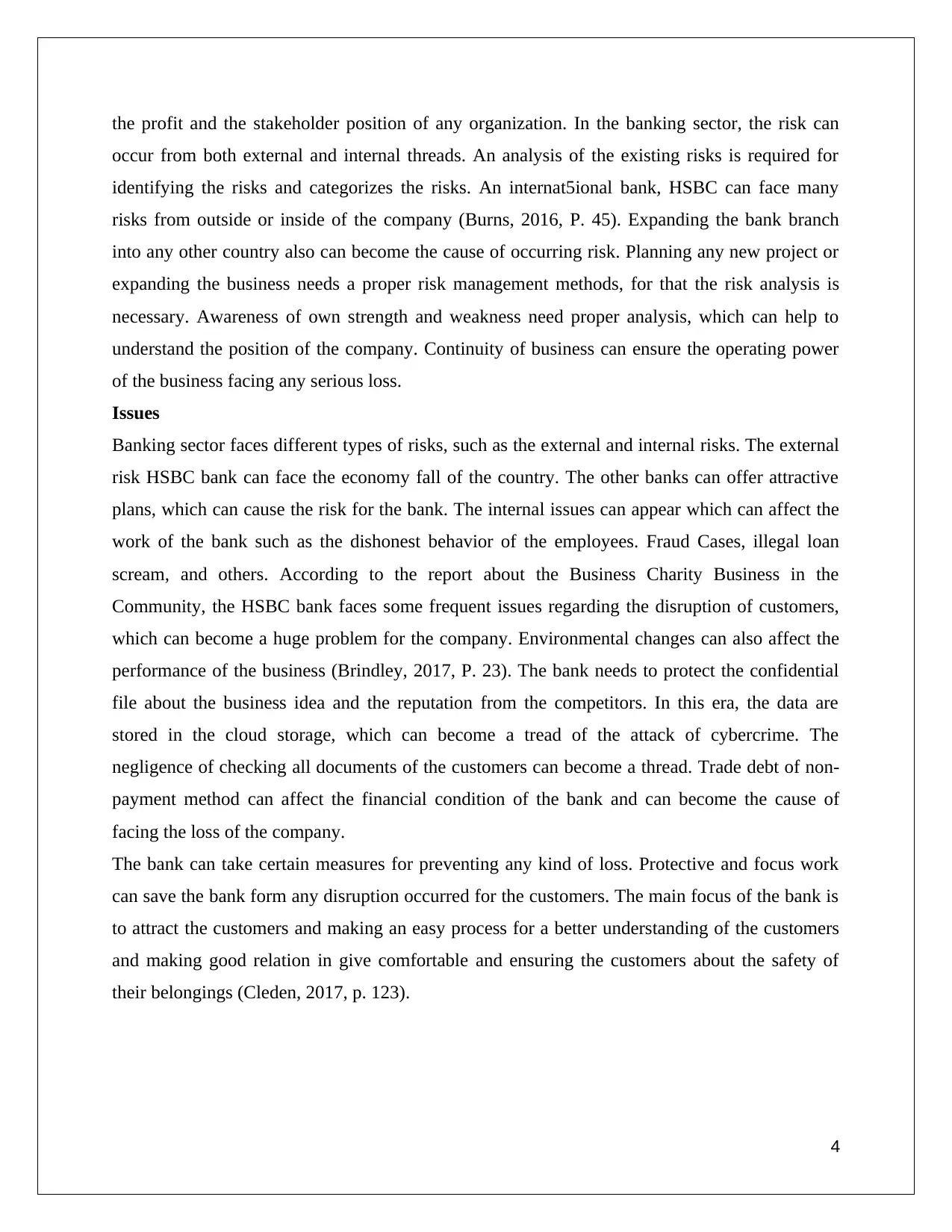
the profit and the stakeholder position of any organization. In the banking sector, the risk can
occur from both external and internal threads. An analysis of the existing risks is required for
identifying the risks and categorizes the risks. An internat5ional bank, HSBC can face many
risks from outside or inside of the company (Burns, 2016, P. 45). Expanding the bank branch
into any other country also can become the cause of occurring risk. Planning any new project or
expanding the business needs a proper risk management methods, for that the risk analysis is
necessary. Awareness of own strength and weakness need proper analysis, which can help to
understand the position of the company. Continuity of business can ensure the operating power
of the business facing any serious loss.
Issues
Banking sector faces different types of risks, such as the external and internal risks. The external
risk HSBC bank can face the economy fall of the country. The other banks can offer attractive
plans, which can cause the risk for the bank. The internal issues can appear which can affect the
work of the bank such as the dishonest behavior of the employees. Fraud Cases, illegal loan
scream, and others. According to the report about the Business Charity Business in the
Community, the HSBC bank faces some frequent issues regarding the disruption of customers,
which can become a huge problem for the company. Environmental changes can also affect the
performance of the business (Brindley, 2017, P. 23). The bank needs to protect the confidential
file about the business idea and the reputation from the competitors. In this era, the data are
stored in the cloud storage, which can become a tread of the attack of cybercrime. The
negligence of checking all documents of the customers can become a thread. Trade debt of non-
payment method can affect the financial condition of the bank and can become the cause of
facing the loss of the company.
The bank can take certain measures for preventing any kind of loss. Protective and focus work
can save the bank form any disruption occurred for the customers. The main focus of the bank is
to attract the customers and making an easy process for a better understanding of the customers
and making good relation in give comfortable and ensuring the customers about the safety of
their belongings (Cleden, 2017, p. 123).
4
occur from both external and internal threads. An analysis of the existing risks is required for
identifying the risks and categorizes the risks. An internat5ional bank, HSBC can face many
risks from outside or inside of the company (Burns, 2016, P. 45). Expanding the bank branch
into any other country also can become the cause of occurring risk. Planning any new project or
expanding the business needs a proper risk management methods, for that the risk analysis is
necessary. Awareness of own strength and weakness need proper analysis, which can help to
understand the position of the company. Continuity of business can ensure the operating power
of the business facing any serious loss.
Issues
Banking sector faces different types of risks, such as the external and internal risks. The external
risk HSBC bank can face the economy fall of the country. The other banks can offer attractive
plans, which can cause the risk for the bank. The internal issues can appear which can affect the
work of the bank such as the dishonest behavior of the employees. Fraud Cases, illegal loan
scream, and others. According to the report about the Business Charity Business in the
Community, the HSBC bank faces some frequent issues regarding the disruption of customers,
which can become a huge problem for the company. Environmental changes can also affect the
performance of the business (Brindley, 2017, P. 23). The bank needs to protect the confidential
file about the business idea and the reputation from the competitors. In this era, the data are
stored in the cloud storage, which can become a tread of the attack of cybercrime. The
negligence of checking all documents of the customers can become a thread. Trade debt of non-
payment method can affect the financial condition of the bank and can become the cause of
facing the loss of the company.
The bank can take certain measures for preventing any kind of loss. Protective and focus work
can save the bank form any disruption occurred for the customers. The main focus of the bank is
to attract the customers and making an easy process for a better understanding of the customers
and making good relation in give comfortable and ensuring the customers about the safety of
their belongings (Cleden, 2017, p. 123).
4
Paraphrase This Document
Need a fresh take? Get an instant paraphrase of this document with our AI Paraphraser
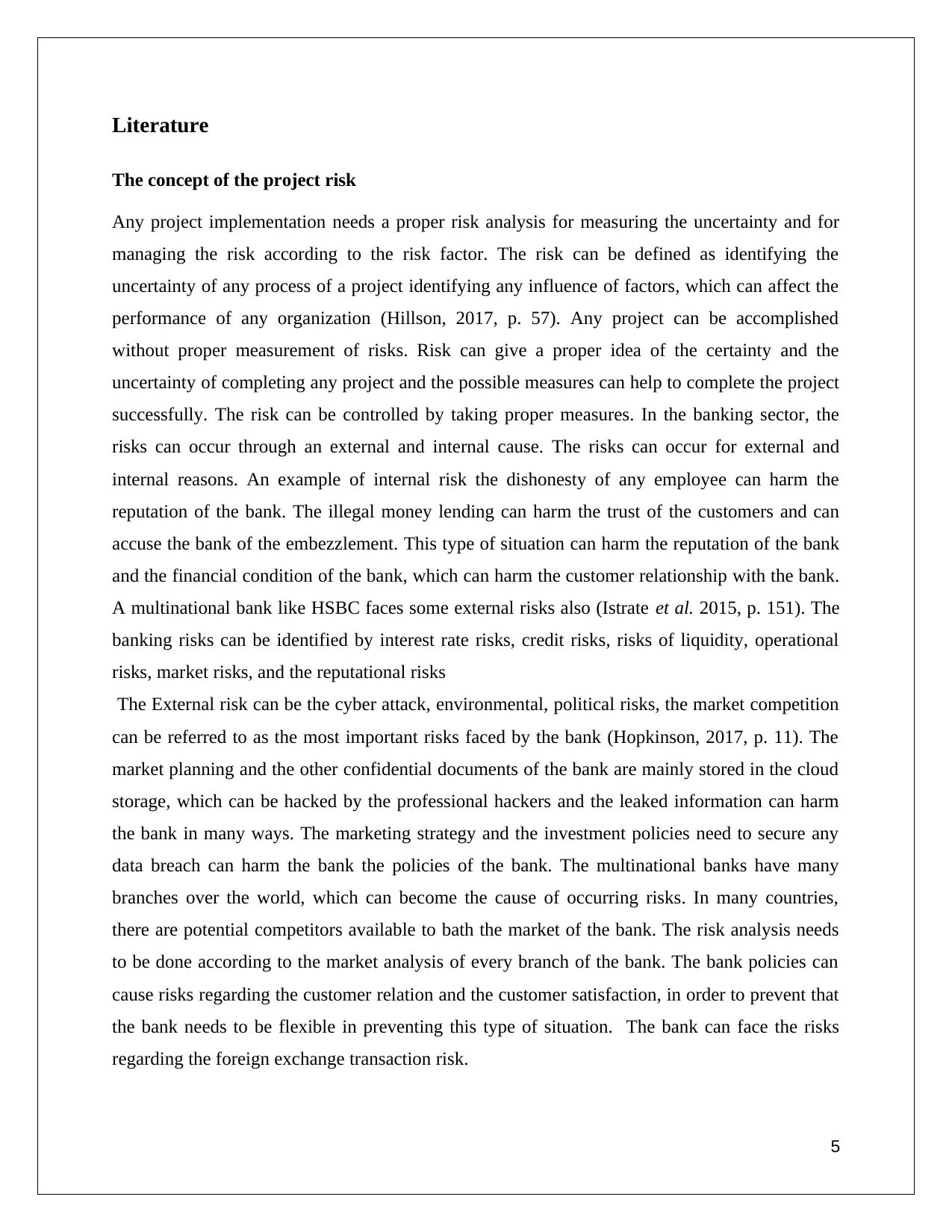
Literature
The concept of the project risk
Any project implementation needs a proper risk analysis for measuring the uncertainty and for
managing the risk according to the risk factor. The risk can be defined as identifying the
uncertainty of any process of a project identifying any influence of factors, which can affect the
performance of any organization (Hillson, 2017, p. 57). Any project can be accomplished
without proper measurement of risks. Risk can give a proper idea of the certainty and the
uncertainty of completing any project and the possible measures can help to complete the project
successfully. The risk can be controlled by taking proper measures. In the banking sector, the
risks can occur through an external and internal cause. The risks can occur for external and
internal reasons. An example of internal risk the dishonesty of any employee can harm the
reputation of the bank. The illegal money lending can harm the trust of the customers and can
accuse the bank of the embezzlement. This type of situation can harm the reputation of the bank
and the financial condition of the bank, which can harm the customer relationship with the bank.
A multinational bank like HSBC faces some external risks also (Istrate et al. 2015, p. 151). The
banking risks can be identified by interest rate risks, credit risks, risks of liquidity, operational
risks, market risks, and the reputational risks
The External risk can be the cyber attack, environmental, political risks, the market competition
can be referred to as the most important risks faced by the bank (Hopkinson, 2017, p. 11). The
market planning and the other confidential documents of the bank are mainly stored in the cloud
storage, which can be hacked by the professional hackers and the leaked information can harm
the bank in many ways. The marketing strategy and the investment policies need to secure any
data breach can harm the bank the policies of the bank. The multinational banks have many
branches over the world, which can become the cause of occurring risks. In many countries,
there are potential competitors available to bath the market of the bank. The risk analysis needs
to be done according to the market analysis of every branch of the bank. The bank policies can
cause risks regarding the customer relation and the customer satisfaction, in order to prevent that
the bank needs to be flexible in preventing this type of situation. The bank can face the risks
regarding the foreign exchange transaction risk.
5
The concept of the project risk
Any project implementation needs a proper risk analysis for measuring the uncertainty and for
managing the risk according to the risk factor. The risk can be defined as identifying the
uncertainty of any process of a project identifying any influence of factors, which can affect the
performance of any organization (Hillson, 2017, p. 57). Any project can be accomplished
without proper measurement of risks. Risk can give a proper idea of the certainty and the
uncertainty of completing any project and the possible measures can help to complete the project
successfully. The risk can be controlled by taking proper measures. In the banking sector, the
risks can occur through an external and internal cause. The risks can occur for external and
internal reasons. An example of internal risk the dishonesty of any employee can harm the
reputation of the bank. The illegal money lending can harm the trust of the customers and can
accuse the bank of the embezzlement. This type of situation can harm the reputation of the bank
and the financial condition of the bank, which can harm the customer relationship with the bank.
A multinational bank like HSBC faces some external risks also (Istrate et al. 2015, p. 151). The
banking risks can be identified by interest rate risks, credit risks, risks of liquidity, operational
risks, market risks, and the reputational risks
The External risk can be the cyber attack, environmental, political risks, the market competition
can be referred to as the most important risks faced by the bank (Hopkinson, 2017, p. 11). The
market planning and the other confidential documents of the bank are mainly stored in the cloud
storage, which can be hacked by the professional hackers and the leaked information can harm
the bank in many ways. The marketing strategy and the investment policies need to secure any
data breach can harm the bank the policies of the bank. The multinational banks have many
branches over the world, which can become the cause of occurring risks. In many countries,
there are potential competitors available to bath the market of the bank. The risk analysis needs
to be done according to the market analysis of every branch of the bank. The bank policies can
cause risks regarding the customer relation and the customer satisfaction, in order to prevent that
the bank needs to be flexible in preventing this type of situation. The bank can face the risks
regarding the foreign exchange transaction risk.
5
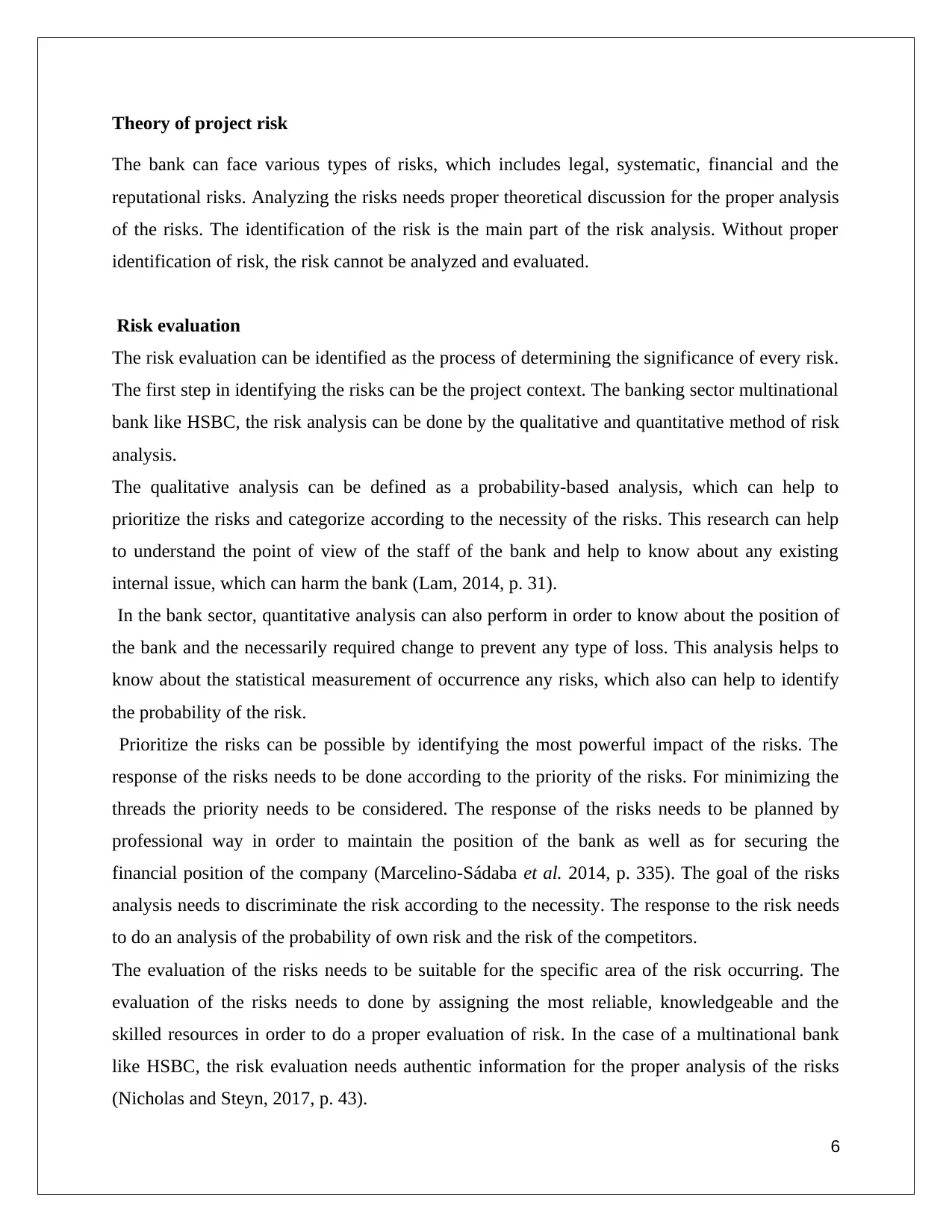
Theory of project risk
The bank can face various types of risks, which includes legal, systematic, financial and the
reputational risks. Analyzing the risks needs proper theoretical discussion for the proper analysis
of the risks. The identification of the risk is the main part of the risk analysis. Without proper
identification of risk, the risk cannot be analyzed and evaluated.
Risk evaluation
The risk evaluation can be identified as the process of determining the significance of every risk.
The first step in identifying the risks can be the project context. The banking sector multinational
bank like HSBC, the risk analysis can be done by the qualitative and quantitative method of risk
analysis.
The qualitative analysis can be defined as a probability-based analysis, which can help to
prioritize the risks and categorize according to the necessity of the risks. This research can help
to understand the point of view of the staff of the bank and help to know about any existing
internal issue, which can harm the bank (Lam, 2014, p. 31).
In the bank sector, quantitative analysis can also perform in order to know about the position of
the bank and the necessarily required change to prevent any type of loss. This analysis helps to
know about the statistical measurement of occurrence any risks, which also can help to identify
the probability of the risk.
Prioritize the risks can be possible by identifying the most powerful impact of the risks. The
response of the risks needs to be done according to the priority of the risks. For minimizing the
threads the priority needs to be considered. The response of the risks needs to be planned by
professional way in order to maintain the position of the bank as well as for securing the
financial position of the company (Marcelino-Sádaba et al. 2014, p. 335). The goal of the risks
analysis needs to discriminate the risk according to the necessity. The response to the risk needs
to do an analysis of the probability of own risk and the risk of the competitors.
The evaluation of the risks needs to be suitable for the specific area of the risk occurring. The
evaluation of the risks needs to done by assigning the most reliable, knowledgeable and the
skilled resources in order to do a proper evaluation of risk. In the case of a multinational bank
like HSBC, the risk evaluation needs authentic information for the proper analysis of the risks
(Nicholas and Steyn, 2017, p. 43).
6
The bank can face various types of risks, which includes legal, systematic, financial and the
reputational risks. Analyzing the risks needs proper theoretical discussion for the proper analysis
of the risks. The identification of the risk is the main part of the risk analysis. Without proper
identification of risk, the risk cannot be analyzed and evaluated.
Risk evaluation
The risk evaluation can be identified as the process of determining the significance of every risk.
The first step in identifying the risks can be the project context. The banking sector multinational
bank like HSBC, the risk analysis can be done by the qualitative and quantitative method of risk
analysis.
The qualitative analysis can be defined as a probability-based analysis, which can help to
prioritize the risks and categorize according to the necessity of the risks. This research can help
to understand the point of view of the staff of the bank and help to know about any existing
internal issue, which can harm the bank (Lam, 2014, p. 31).
In the bank sector, quantitative analysis can also perform in order to know about the position of
the bank and the necessarily required change to prevent any type of loss. This analysis helps to
know about the statistical measurement of occurrence any risks, which also can help to identify
the probability of the risk.
Prioritize the risks can be possible by identifying the most powerful impact of the risks. The
response of the risks needs to be done according to the priority of the risks. For minimizing the
threads the priority needs to be considered. The response of the risks needs to be planned by
professional way in order to maintain the position of the bank as well as for securing the
financial position of the company (Marcelino-Sádaba et al. 2014, p. 335). The goal of the risks
analysis needs to discriminate the risk according to the necessity. The response to the risk needs
to do an analysis of the probability of own risk and the risk of the competitors.
The evaluation of the risks needs to be suitable for the specific area of the risk occurring. The
evaluation of the risks needs to done by assigning the most reliable, knowledgeable and the
skilled resources in order to do a proper evaluation of risk. In the case of a multinational bank
like HSBC, the risk evaluation needs authentic information for the proper analysis of the risks
(Nicholas and Steyn, 2017, p. 43).
6
⊘ This is a preview!⊘
Do you want full access?
Subscribe today to unlock all pages.

Trusted by 1+ million students worldwide
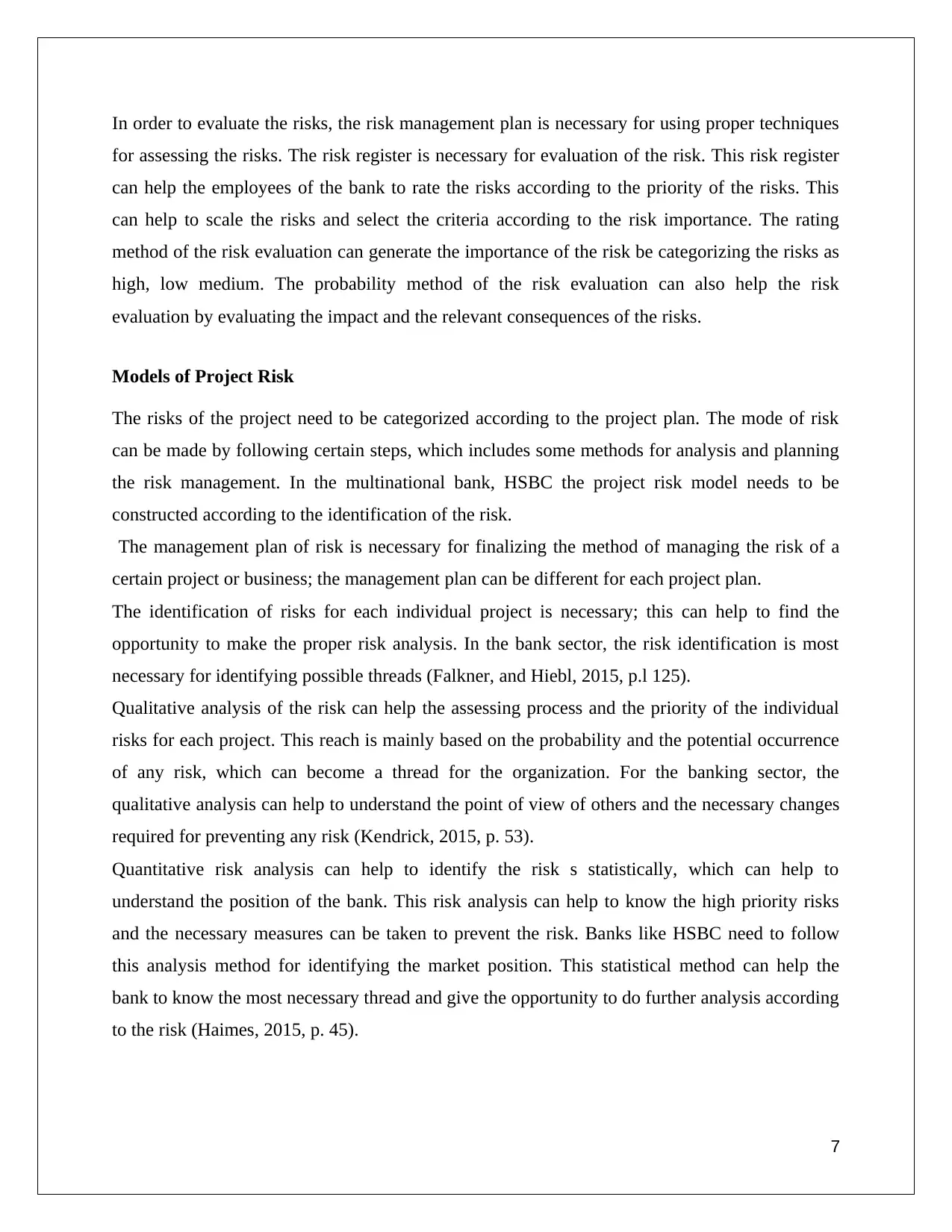
In order to evaluate the risks, the risk management plan is necessary for using proper techniques
for assessing the risks. The risk register is necessary for evaluation of the risk. This risk register
can help the employees of the bank to rate the risks according to the priority of the risks. This
can help to scale the risks and select the criteria according to the risk importance. The rating
method of the risk evaluation can generate the importance of the risk be categorizing the risks as
high, low medium. The probability method of the risk evaluation can also help the risk
evaluation by evaluating the impact and the relevant consequences of the risks.
Models of Project Risk
The risks of the project need to be categorized according to the project plan. The mode of risk
can be made by following certain steps, which includes some methods for analysis and planning
the risk management. In the multinational bank, HSBC the project risk model needs to be
constructed according to the identification of the risk.
The management plan of risk is necessary for finalizing the method of managing the risk of a
certain project or business; the management plan can be different for each project plan.
The identification of risks for each individual project is necessary; this can help to find the
opportunity to make the proper risk analysis. In the bank sector, the risk identification is most
necessary for identifying possible threads (Falkner, and Hiebl, 2015, p.l 125).
Qualitative analysis of the risk can help the assessing process and the priority of the individual
risks for each project. This reach is mainly based on the probability and the potential occurrence
of any risk, which can become a thread for the organization. For the banking sector, the
qualitative analysis can help to understand the point of view of others and the necessary changes
required for preventing any risk (Kendrick, 2015, p. 53).
Quantitative risk analysis can help to identify the risk s statistically, which can help to
understand the position of the bank. This risk analysis can help to know the high priority risks
and the necessary measures can be taken to prevent the risk. Banks like HSBC need to follow
this analysis method for identifying the market position. This statistical method can help the
bank to know the most necessary thread and give the opportunity to do further analysis according
to the risk (Haimes, 2015, p. 45).
7
for assessing the risks. The risk register is necessary for evaluation of the risk. This risk register
can help the employees of the bank to rate the risks according to the priority of the risks. This
can help to scale the risks and select the criteria according to the risk importance. The rating
method of the risk evaluation can generate the importance of the risk be categorizing the risks as
high, low medium. The probability method of the risk evaluation can also help the risk
evaluation by evaluating the impact and the relevant consequences of the risks.
Models of Project Risk
The risks of the project need to be categorized according to the project plan. The mode of risk
can be made by following certain steps, which includes some methods for analysis and planning
the risk management. In the multinational bank, HSBC the project risk model needs to be
constructed according to the identification of the risk.
The management plan of risk is necessary for finalizing the method of managing the risk of a
certain project or business; the management plan can be different for each project plan.
The identification of risks for each individual project is necessary; this can help to find the
opportunity to make the proper risk analysis. In the bank sector, the risk identification is most
necessary for identifying possible threads (Falkner, and Hiebl, 2015, p.l 125).
Qualitative analysis of the risk can help the assessing process and the priority of the individual
risks for each project. This reach is mainly based on the probability and the potential occurrence
of any risk, which can become a thread for the organization. For the banking sector, the
qualitative analysis can help to understand the point of view of others and the necessary changes
required for preventing any risk (Kendrick, 2015, p. 53).
Quantitative risk analysis can help to identify the risk s statistically, which can help to
understand the position of the bank. This risk analysis can help to know the high priority risks
and the necessary measures can be taken to prevent the risk. Banks like HSBC need to follow
this analysis method for identifying the market position. This statistical method can help the
bank to know the most necessary thread and give the opportunity to do further analysis according
to the risk (Haimes, 2015, p. 45).
7
Paraphrase This Document
Need a fresh take? Get an instant paraphrase of this document with our AI Paraphraser
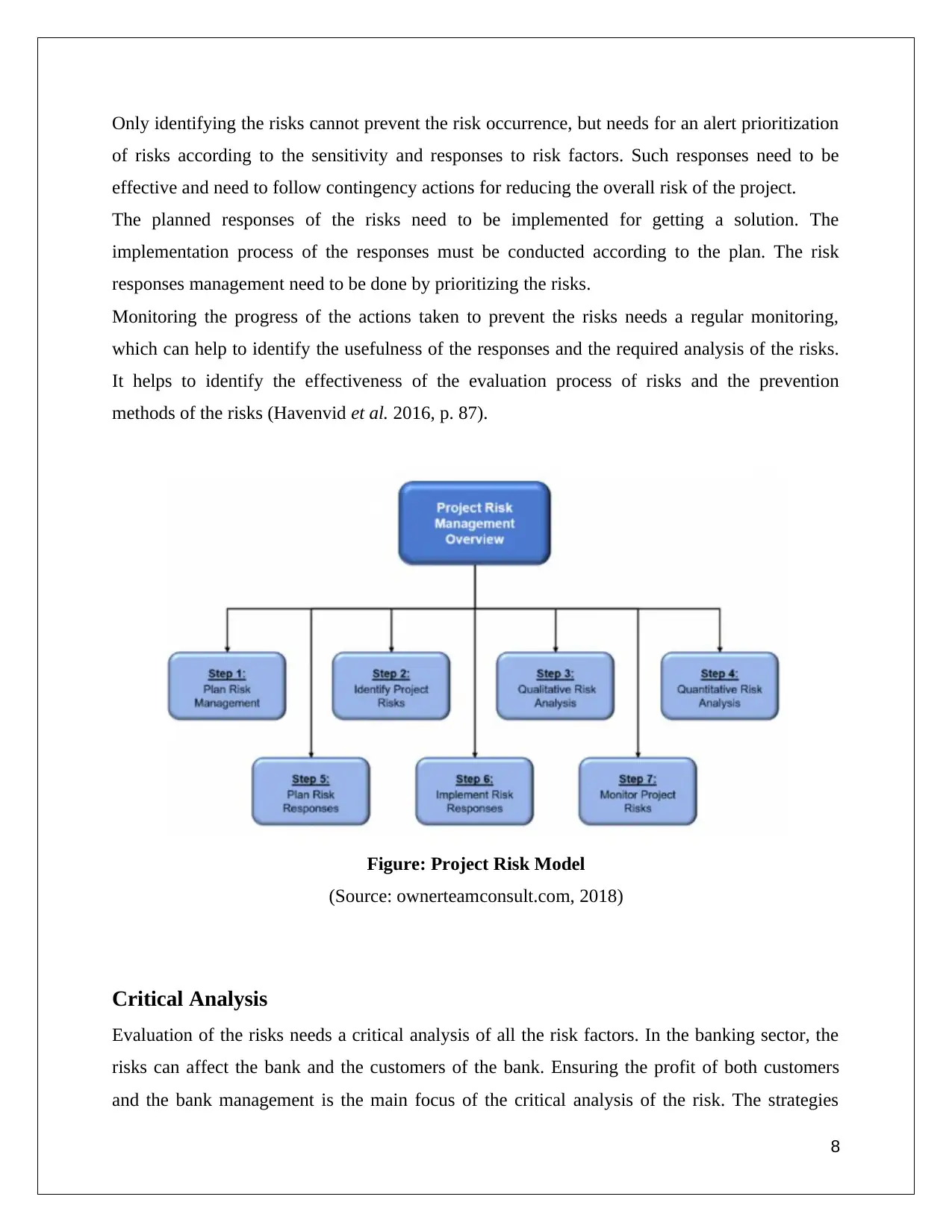
Only identifying the risks cannot prevent the risk occurrence, but needs for an alert prioritization
of risks according to the sensitivity and responses to risk factors. Such responses need to be
effective and need to follow contingency actions for reducing the overall risk of the project.
The planned responses of the risks need to be implemented for getting a solution. The
implementation process of the responses must be conducted according to the plan. The risk
responses management need to be done by prioritizing the risks.
Monitoring the progress of the actions taken to prevent the risks needs a regular monitoring,
which can help to identify the usefulness of the responses and the required analysis of the risks.
It helps to identify the effectiveness of the evaluation process of risks and the prevention
methods of the risks (Havenvid et al. 2016, p. 87).
Figure: Project Risk Model
(Source: ownerteamconsult.com, 2018)
Critical Analysis
Evaluation of the risks needs a critical analysis of all the risk factors. In the banking sector, the
risks can affect the bank and the customers of the bank. Ensuring the profit of both customers
and the bank management is the main focus of the critical analysis of the risk. The strategies
8
of risks according to the sensitivity and responses to risk factors. Such responses need to be
effective and need to follow contingency actions for reducing the overall risk of the project.
The planned responses of the risks need to be implemented for getting a solution. The
implementation process of the responses must be conducted according to the plan. The risk
responses management need to be done by prioritizing the risks.
Monitoring the progress of the actions taken to prevent the risks needs a regular monitoring,
which can help to identify the usefulness of the responses and the required analysis of the risks.
It helps to identify the effectiveness of the evaluation process of risks and the prevention
methods of the risks (Havenvid et al. 2016, p. 87).
Figure: Project Risk Model
(Source: ownerteamconsult.com, 2018)
Critical Analysis
Evaluation of the risks needs a critical analysis of all the risk factors. In the banking sector, the
risks can affect the bank and the customers of the bank. Ensuring the profit of both customers
and the bank management is the main focus of the critical analysis of the risk. The strategies
8
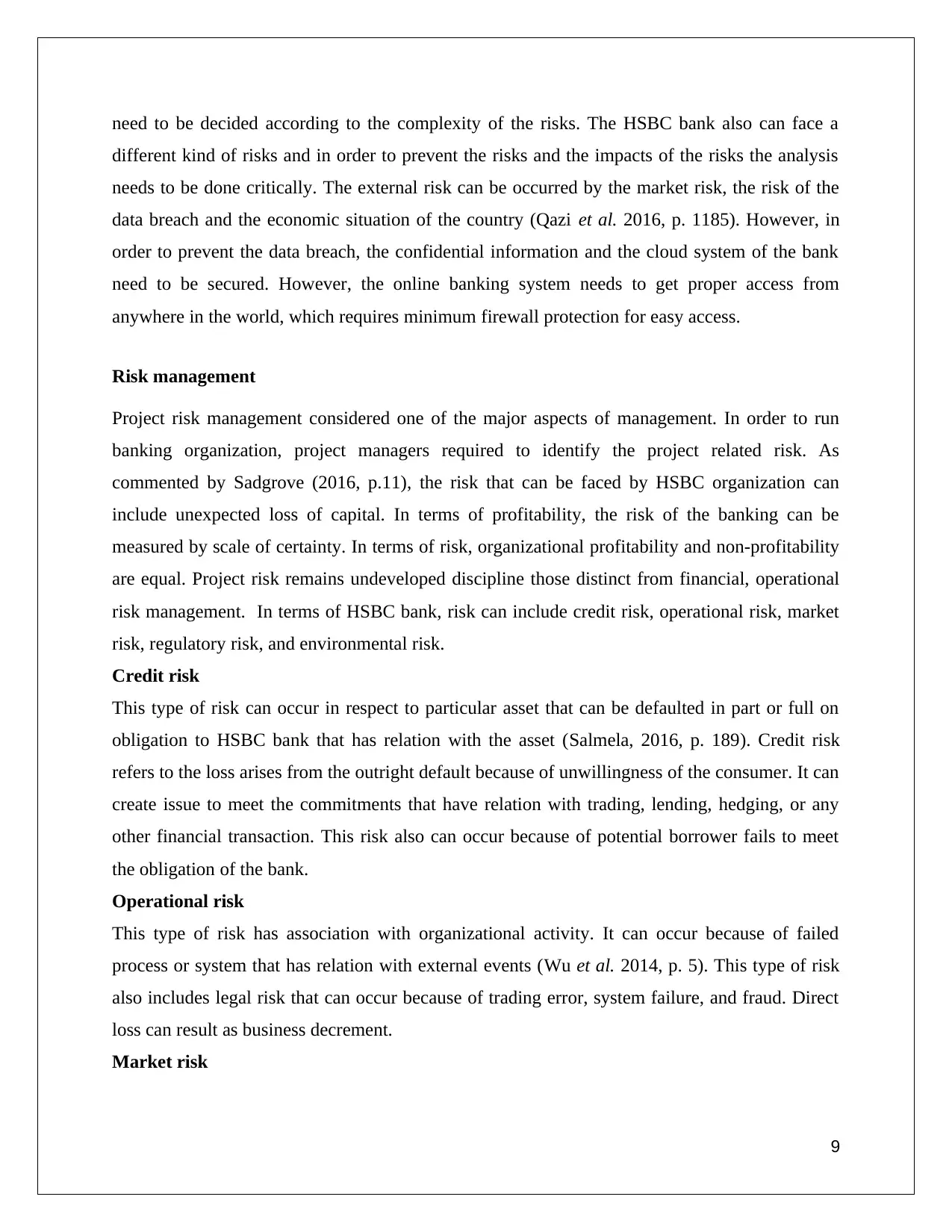
need to be decided according to the complexity of the risks. The HSBC bank also can face a
different kind of risks and in order to prevent the risks and the impacts of the risks the analysis
needs to be done critically. The external risk can be occurred by the market risk, the risk of the
data breach and the economic situation of the country (Qazi et al. 2016, p. 1185). However, in
order to prevent the data breach, the confidential information and the cloud system of the bank
need to be secured. However, the online banking system needs to get proper access from
anywhere in the world, which requires minimum firewall protection for easy access.
Risk management
Project risk management considered one of the major aspects of management. In order to run
banking organization, project managers required to identify the project related risk. As
commented by Sadgrove (2016, p.11), the risk that can be faced by HSBC organization can
include unexpected loss of capital. In terms of profitability, the risk of the banking can be
measured by scale of certainty. In terms of risk, organizational profitability and non-profitability
are equal. Project risk remains undeveloped discipline those distinct from financial, operational
risk management. In terms of HSBC bank, risk can include credit risk, operational risk, market
risk, regulatory risk, and environmental risk.
Credit risk
This type of risk can occur in respect to particular asset that can be defaulted in part or full on
obligation to HSBC bank that has relation with the asset (Salmela, 2016, p. 189). Credit risk
refers to the loss arises from the outright default because of unwillingness of the consumer. It can
create issue to meet the commitments that have relation with trading, lending, hedging, or any
other financial transaction. This risk also can occur because of potential borrower fails to meet
the obligation of the bank.
Operational risk
This type of risk has association with organizational activity. It can occur because of failed
process or system that has relation with external events (Wu et al. 2014, p. 5). This type of risk
also includes legal risk that can occur because of trading error, system failure, and fraud. Direct
loss can result as business decrement.
Market risk
9
different kind of risks and in order to prevent the risks and the impacts of the risks the analysis
needs to be done critically. The external risk can be occurred by the market risk, the risk of the
data breach and the economic situation of the country (Qazi et al. 2016, p. 1185). However, in
order to prevent the data breach, the confidential information and the cloud system of the bank
need to be secured. However, the online banking system needs to get proper access from
anywhere in the world, which requires minimum firewall protection for easy access.
Risk management
Project risk management considered one of the major aspects of management. In order to run
banking organization, project managers required to identify the project related risk. As
commented by Sadgrove (2016, p.11), the risk that can be faced by HSBC organization can
include unexpected loss of capital. In terms of profitability, the risk of the banking can be
measured by scale of certainty. In terms of risk, organizational profitability and non-profitability
are equal. Project risk remains undeveloped discipline those distinct from financial, operational
risk management. In terms of HSBC bank, risk can include credit risk, operational risk, market
risk, regulatory risk, and environmental risk.
Credit risk
This type of risk can occur in respect to particular asset that can be defaulted in part or full on
obligation to HSBC bank that has relation with the asset (Salmela, 2016, p. 189). Credit risk
refers to the loss arises from the outright default because of unwillingness of the consumer. It can
create issue to meet the commitments that have relation with trading, lending, hedging, or any
other financial transaction. This risk also can occur because of potential borrower fails to meet
the obligation of the bank.
Operational risk
This type of risk has association with organizational activity. It can occur because of failed
process or system that has relation with external events (Wu et al. 2014, p. 5). This type of risk
also includes legal risk that can occur because of trading error, system failure, and fraud. Direct
loss can result as business decrement.
Market risk
9
⊘ This is a preview!⊘
Do you want full access?
Subscribe today to unlock all pages.

Trusted by 1+ million students worldwide

Market risk of HSBC banking project can create possibility of loss that can arise because of
change variables like foreign exchange, interest rate, commodity, and equity price. Market risk
can also include volatility degree of bond, equity, security, foreign exchange. These things
change daily loss and profit over particular time.
Ways to implement and construct a Project risk management strategy:
A planned strategy of risk reduction initiatives should be performed and assessing the
impact of such actions. Their aim is to focus on greater-priority risks and also calls for
changing needs in the way to progress.
An aim to consider the residual risks while tracking and establishing the way to manage
the contingency and other uncertainties.
Reducing individual risks by giving a person adequate resources and authority in order to
carry out the assigned plan.
Risk minimizing
In order to minimize the market risk, HSBC organization can use proper risk management tool
that would help the investor to protect investment. Marketing risk of HSBC bank can be
minimized by understanding financial and corporate tools (Zhang et al. 2018, p. 1). Risk can be
managed by direct risk influence and behavior, which shapes the organizational available
options. Risk can be controlled by using information related to the banking project properly.
Diversification is another important way to manage banking project risk. Governance system
needs to be utilized and monitored properly in order to mitigate the project risk.
Conclusion
Risk analysis of the project needs to be done for ensuring the uncertainty of the project. In this
study, the risk analysis is done for the international bank HSBC. in the banking sector, the risks
can occur from externally and internally in order to prevent that this study can help. This study
can help to conclude the scope of the risk analysis and the different type of risks can occur. A
thorough understanding of the risk of the project and the possible issues of any bank sector
project is discussed here. A thorough literature review has been included in this study, which
helps to identify the concept of the project risk, and the necessary theory required for the risk
10
change variables like foreign exchange, interest rate, commodity, and equity price. Market risk
can also include volatility degree of bond, equity, security, foreign exchange. These things
change daily loss and profit over particular time.
Ways to implement and construct a Project risk management strategy:
A planned strategy of risk reduction initiatives should be performed and assessing the
impact of such actions. Their aim is to focus on greater-priority risks and also calls for
changing needs in the way to progress.
An aim to consider the residual risks while tracking and establishing the way to manage
the contingency and other uncertainties.
Reducing individual risks by giving a person adequate resources and authority in order to
carry out the assigned plan.
Risk minimizing
In order to minimize the market risk, HSBC organization can use proper risk management tool
that would help the investor to protect investment. Marketing risk of HSBC bank can be
minimized by understanding financial and corporate tools (Zhang et al. 2018, p. 1). Risk can be
managed by direct risk influence and behavior, which shapes the organizational available
options. Risk can be controlled by using information related to the banking project properly.
Diversification is another important way to manage banking project risk. Governance system
needs to be utilized and monitored properly in order to mitigate the project risk.
Conclusion
Risk analysis of the project needs to be done for ensuring the uncertainty of the project. In this
study, the risk analysis is done for the international bank HSBC. in the banking sector, the risks
can occur from externally and internally in order to prevent that this study can help. This study
can help to conclude the scope of the risk analysis and the different type of risks can occur. A
thorough understanding of the risk of the project and the possible issues of any bank sector
project is discussed here. A thorough literature review has been included in this study, which
helps to identify the concept of the project risk, and the necessary theory required for the risk
10
Paraphrase This Document
Need a fresh take? Get an instant paraphrase of this document with our AI Paraphraser
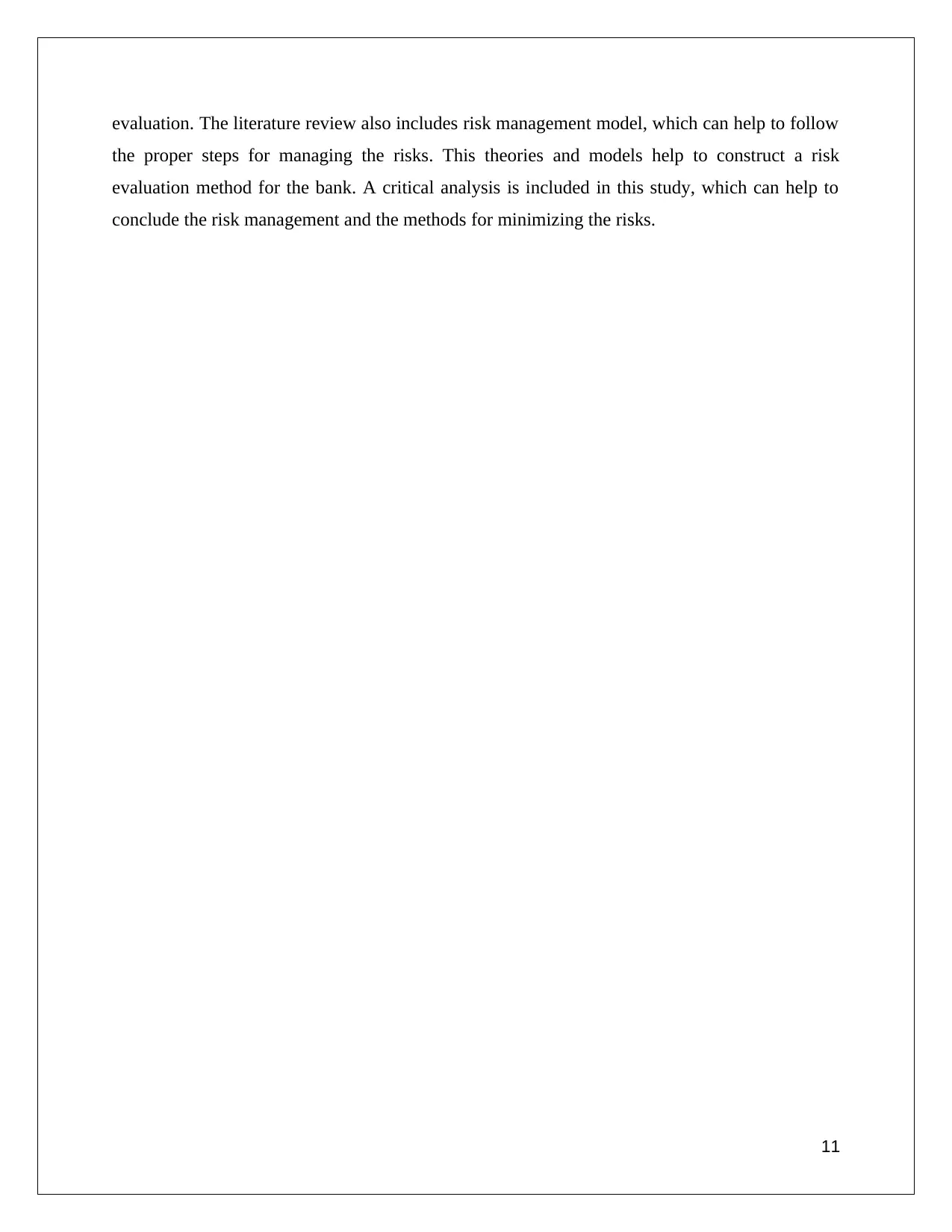
evaluation. The literature review also includes risk management model, which can help to follow
the proper steps for managing the risks. This theories and models help to construct a risk
evaluation method for the bank. A critical analysis is included in this study, which can help to
conclude the risk management and the methods for minimizing the risks.
11
the proper steps for managing the risks. This theories and models help to construct a risk
evaluation method for the bank. A critical analysis is included in this study, which can help to
conclude the risk management and the methods for minimizing the risks.
11
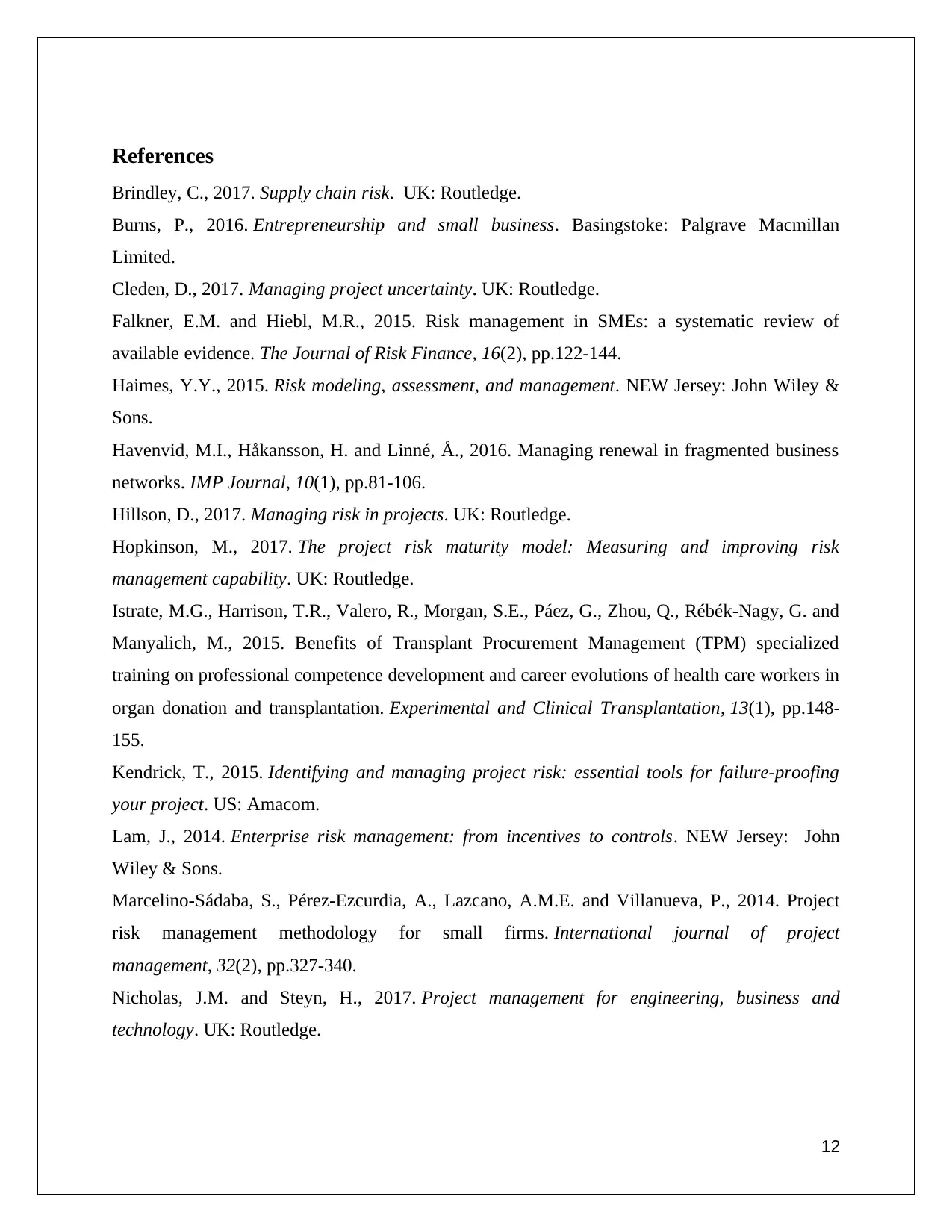
References
Brindley, C., 2017. Supply chain risk. UK: Routledge.
Burns, P., 2016. Entrepreneurship and small business. Basingstoke: Palgrave Macmillan
Limited.
Cleden, D., 2017. Managing project uncertainty. UK: Routledge.
Falkner, E.M. and Hiebl, M.R., 2015. Risk management in SMEs: a systematic review of
available evidence. The Journal of Risk Finance, 16(2), pp.122-144.
Haimes, Y.Y., 2015. Risk modeling, assessment, and management. NEW Jersey: John Wiley &
Sons.
Havenvid, M.I., Håkansson, H. and Linné, Å., 2016. Managing renewal in fragmented business
networks. IMP Journal, 10(1), pp.81-106.
Hillson, D., 2017. Managing risk in projects. UK: Routledge.
Hopkinson, M., 2017. The project risk maturity model: Measuring and improving risk
management capability. UK: Routledge.
Istrate, M.G., Harrison, T.R., Valero, R., Morgan, S.E., Páez, G., Zhou, Q., Rébék-Nagy, G. and
Manyalich, M., 2015. Benefits of Transplant Procurement Management (TPM) specialized
training on professional competence development and career evolutions of health care workers in
organ donation and transplantation. Experimental and Clinical Transplantation, 13(1), pp.148-
155.
Kendrick, T., 2015. Identifying and managing project risk: essential tools for failure-proofing
your project. US: Amacom.
Lam, J., 2014. Enterprise risk management: from incentives to controls. NEW Jersey: John
Wiley & Sons.
Marcelino-Sádaba, S., Pérez-Ezcurdia, A., Lazcano, A.M.E. and Villanueva, P., 2014. Project
risk management methodology for small firms. International journal of project
management, 32(2), pp.327-340.
Nicholas, J.M. and Steyn, H., 2017. Project management for engineering, business and
technology. UK: Routledge.
12
Brindley, C., 2017. Supply chain risk. UK: Routledge.
Burns, P., 2016. Entrepreneurship and small business. Basingstoke: Palgrave Macmillan
Limited.
Cleden, D., 2017. Managing project uncertainty. UK: Routledge.
Falkner, E.M. and Hiebl, M.R., 2015. Risk management in SMEs: a systematic review of
available evidence. The Journal of Risk Finance, 16(2), pp.122-144.
Haimes, Y.Y., 2015. Risk modeling, assessment, and management. NEW Jersey: John Wiley &
Sons.
Havenvid, M.I., Håkansson, H. and Linné, Å., 2016. Managing renewal in fragmented business
networks. IMP Journal, 10(1), pp.81-106.
Hillson, D., 2017. Managing risk in projects. UK: Routledge.
Hopkinson, M., 2017. The project risk maturity model: Measuring and improving risk
management capability. UK: Routledge.
Istrate, M.G., Harrison, T.R., Valero, R., Morgan, S.E., Páez, G., Zhou, Q., Rébék-Nagy, G. and
Manyalich, M., 2015. Benefits of Transplant Procurement Management (TPM) specialized
training on professional competence development and career evolutions of health care workers in
organ donation and transplantation. Experimental and Clinical Transplantation, 13(1), pp.148-
155.
Kendrick, T., 2015. Identifying and managing project risk: essential tools for failure-proofing
your project. US: Amacom.
Lam, J., 2014. Enterprise risk management: from incentives to controls. NEW Jersey: John
Wiley & Sons.
Marcelino-Sádaba, S., Pérez-Ezcurdia, A., Lazcano, A.M.E. and Villanueva, P., 2014. Project
risk management methodology for small firms. International journal of project
management, 32(2), pp.327-340.
Nicholas, J.M. and Steyn, H., 2017. Project management for engineering, business and
technology. UK: Routledge.
12
⊘ This is a preview!⊘
Do you want full access?
Subscribe today to unlock all pages.

Trusted by 1+ million students worldwide
1 out of 13
Related Documents
Your All-in-One AI-Powered Toolkit for Academic Success.
+13062052269
info@desklib.com
Available 24*7 on WhatsApp / Email
![[object Object]](/_next/static/media/star-bottom.7253800d.svg)
Unlock your academic potential
Copyright © 2020–2025 A2Z Services. All Rights Reserved. Developed and managed by ZUCOL.





